Price reductions at Crocus
by Sarah - January 10th, 2010.Filed under: Crocus, Price Reductions.
Reduced products at Crocus
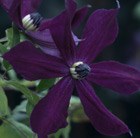
clematis (group 3) was £9.99 now £6.99
Position: full sun or partial shadeSoil: fertile, well-drained, neutral soilRate of growth: averageFlowering period: July to SeptemberFlower colour: dark violetOther features: deeply lobed light green leavesHardiness: fully hardySumptuos purple, star-like blooms up to 8cm across, with violet- violet-tipped stamens are produces prolifically on this non-clinging climber. Introduced for the bicentenary of Victor Hugo’s birth, this is an incredibly free flowering, late summer Clematis, which will (like its namesake) add a bit of drama. Ideal for mixing with climbing roses, or allowed to scramble through open shrubs – it is particularly well suited to cottage garden schemes. Alternatively pot it up using John Innes No3 compost and use it as a mobile focal point.Garden care: Cut back the stems to the base of the plant each winter and apply a mulch of well-rotted garden compost around the plant, avoiding the immediate crown
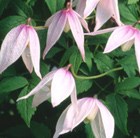
alpine clematis (group 1) was £8.99 now £6.99
Position: full sun or partial shadeSoil: fertile, well-drained soil, neutral soilRate of growth: average to fastFlowering period: April to MayFlower colour: pale pinkOther features: fluffy seed-headsHardiness: fully hardySmall, delicate, bell-shaped flowers that are pale pink darkening to towards the base, with deeper pink undersides and cream anthers. This is early-flowering clematis with flowers appearing from April to May followed by fluffy seed-heads. A great clematis for a north- or east-facing wall or trellis. Given suitable support it may be grown on its own or allowed to scramble through a strong shrub or tree.Garden care: No routine pruning is necessary. If the spread of the plant needs to be restricted prune immediately after flowering, cutting back overlong shoots to healthy buds. Apply a slow-release balanced fertiliser and a mulch of well-rotted garden compost around the base of the plant in early spring.
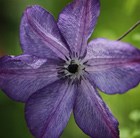
clematis (group 3) was £8.99 now £6.99
Position: full sun or partial shadeSoil: fertile, well-drained, neutral soilRate of growth: fast-growingFlowering period: July to SeptemberFlower colour: purpleOther features: N/AHardiness: fully hardyMagnificent, purple-veined white flowers with deep purple centres produced from July to September. This late flowering clematis looks stunning scrambling through trees, shrubs and climbing roses in full sun or partial shade. Resistant to clematis wilt it stands up well in wind and is suitable for a north-facing site.Garden care: In early spring cut back the previous year’s stems to a pair of strong buds about 15-20cm (6-8in) above ground-level and apply a slow-release balanced fertiliser and a mulch of well-rotted garden compost around the plant, avoiding the immediate crown.
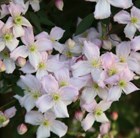
clematis (group 1) was £8.99 now £6.99
Position: full sun or partial shadeSoil: fertile, well-drained, neutral soilRate of growth: fast-growing Flowering period: May and June Flower colour: pinkHardiness: fully hardySweetly scented, pink flowers in May and June amid purple-flushed, mid-green leaves. This vigorous montana clematis is ideal for covering a wall or fence in sun or partial shade. Since it often outgrows the space intended for it, for a small garden we’d advise the less-vigorous Clematis montana var. rubens ‘Freda’.Garden care: No routine pruning is necessary. If the spread of the plant needs to be restricted prune immediately after flowering, cutting back overlong shoots to healthy buds. Apply a slow-release balanced fertiliser and a mulch of well-rotted garden compost around the base of the plant in early spring.
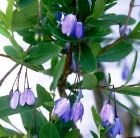
bluebell creeper was £8.99 now £6.99
Position: full sun or partial sunSoil: moderately-fertile, humus-rich, well-drained soilRate of growth: averageFlowering period: June to SeptemberFlower colour: blueOther features: edible blue berriesHardiness: half hardy (borderline)Pretty, pendant, blue, bell-shaped flowers from June to September, followed by edible, blue berries, and lance-shaped, deep green leaves. This unusual, twining, evergreen climber is ideal for training over a pergola or arch in a sheltered, sunny site. Where temperatures fall below 5°C (41°F) it’s best grown under glass and watered sparingly during the winter months. Garden care: Tie twining stems using raffia or garden twine. In the spring cut back the flowered shoots to within 2-4 buds.
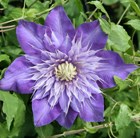
clematis (group 1) was £8.99 now £6.99
Position: full sun or partial shadeSoil: fertile, well-drained soil, neutral soilRate of growth: averageFlowering period: May to June and August to SeptemberFlower colour: deep blueOther features: N/AHardiness: fully hardyLarge, deep blue, double early summer flowers with pale blue centres ending in a silvery-blue spike. This large, early summer flowering clematis makes a perfect companion for a climbing rose in full sun or partial shade. The deep blue flowers look particularly handsome next to yellow-flowered varieties, such as the Rose ‘Golden Showers’.Garden care: While no regular pruning is required, removing the dead stem-tips in late February or early March will keep the plant looking tidy. Apply a slow-release balanced fertiliser and a mulch of well-rotted garden compost around the base of the plant in early spring.
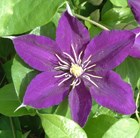
clematis (group 2) was £7.99 now £6.99
Position: full sun or partial shadeSoil: fertile, well-drained soil, neutral soilRate of growth: average to fast-growingFlowering period: May to June and SeptemberFlower colour: bluish-purpleHardiness: fully hardyLarge bluish-purple flowers that have a darker central stripeappear on this early summer flowering variety. In good years you may get a second flush later in the season. A great mixer, it will look brilliant with a soft pink climbing rose such as Rosa Nahema (‘Deleri’), or for a bolder look, try it with Clematis ‘Royal Velours’. It is not too robust so is ideal for growing in a pot.Garden care: Remove dead and damaged stems before growth begins in early spring, cutting all remaining stems back to where strong buds are visible. Apply a slow-release balanced fertiliser and a mulch of of well-rotted garden compost around the base of the plant in early spring.
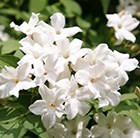
common white jasmine was £7.99 now £6.99
Position: full sunSoil: fertile, well-drained soilRate of growth: fast-growingFlowering period: June to AugustHardiness: frost hardy (needs winter protection)A popular, sweetly scented climber smothered in clusters of highly fragrant white flowers from June to August and pretty, fine foliage. This versatile, deciduous climber appreciates a sheltered, sunny, well-drained site, and can cope with dry conditions. Since it spreads quickly in all directions, it’s ideal for covering a large south or west-facing wall or an unsightly garden building. In small gardens, it is best planted in a pot and trained up a trellis or wall.Garden care: After flowering remove old and over-crowded shoots. Prune hard in autumn to keep it within bounds, but be warned that flowering will be retarded the following year.
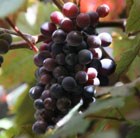
purple-leaved grape vine was £9.99 now £7.99
Position: full sun or partial shadeSoil: well-drained, neutral to slightly alkaline soilRate of growth: fast-growing Flowering period: May and June Flower colour: small, scented, light-green flowersHardiness: fully hardyDeciduous, woody climber with three to five-lobed leaves that are grey-hairy at first, turning plum-purple before becoming dark purple in autumn. Small, unpalatable purple grapes are also produced in autumn. This ornamental vine is cultivated mainly for its stunning leaf colour and is ideal for covering a fence or wall.Garden care: When planting incorporate plenty of well-rotted organic matter in to the planting hole. It will need some help to clamber up a tree, wall or pergola so you will need to provide some support and tie it in as it grows. Once it has developed a good framework you should shorten all the lateral shoots to within two or three buds from the main stem. It is essential that the majority of the pruning work is tackled in mid winter as the sap tends to ‘bleed’ at other times of the year, but you can cut back the odd over-long stem to a healthy bud in summer.
de-wit-long-handled-planting-trowel was £100.00 now £17.99
de-wit-long-handled-hand-fork was £100.00 now £19.99
de-wit-5-tine-hand-rake-with-short-handle was £100.00 now £24.99
de-wit-5-tine-handrake-drop-grip-handle was £100.00 now £29.99
de-wit-small-hoe-rake-with-drop-grip-handle was £100.00 now £29.99
de-wit-hoe-rake was £100.00 now £34.99
de-wit-bow-tine-rake was £100.00 now £39.99
de-wit-ladies-spade was £100.00 now £49.99
de-wit-rose-fork was £100.00 now £49.99
de-wit-ladies-fork was £100.00 now £59.99






